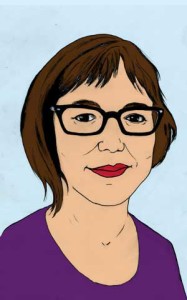 Dear Reader,
Dear Reader,
I had the unexpected pleasure of spending four hours at Harvard’s Fogg Art Museum with my 93-year-old mother-in-law recently. Not that visiting the Fogg is unusual—we’ve done it for years, practically every summer. But this time we spent four hours looking at art!
As we sat in the café area, realizing we wouldn’t be enjoying our planned leisurely lunch—a COVID casualty—my mother-in-law stabbed her cane into the floor as she creaked up out of her chair, signaling let’s get started. One of the first paintings we lingered over was a Kerry James Marshall self-portrait of the artist holding a paint brush and jumbo-sized palette in the foreground. I leaned over to tell my mother-in-law a little about the artist and his importance in the art world. She listened intently, then responded, “Hmm.” We then walked away in different directions, on to the next piece—being mindful to give one another our own time with each work. I noticed how my mother-in-law stayed with every piece, much longer than most museumgoers (who apparently spend an average of three seconds with each painting). She would read the placard, study the piece, then refer to the placard again. If something was of particular interest, she would come over to me and comment on what she had just learned. We would then look at the piece together, with me often elaborating upon it.
We wandered through the museum’s impressive permanent collection, starting with Modernism, ending with contemporary art. We oohed and aahed at the Pollock, wondering if it was incorrectly hung, as it was atypically vertical. When we got to a Louise Nevelson, my mother-in-law was blown away by the large black wall sculpture—she was not familiar with Nevelson’s work. We sat in silence on a bench positioned directly in front of the entire piece. I wondered aloud if all of the black painted wooden shapes were found items. I walked toward the placard and announced that indeed they were. We started pointing out each form that we found particularly interesting or discovering something so obvious, like a leg of a chair. I related how Nevelson, one of the few women sculptors of her time, once stood up at a sculpture conference and proclaimed “I have balls too!” My mother-in-law smirked a little at that story.
We were approaching a curtained-off room at the end of the exhibition where a film was screening, and I asked ma-in-law if she wanted to watch it. We both liked the idea of sitting in a darkened room and resting our weary feet. The short film—Phat Free by David Hammons—was shot with a hand-held camera as it followed Hammons kicking a bucket down the streets of New York City at night. The only sound was the clanging of the bucket rolling on the pavement with peripheral city noises. We sat in silence; mesmerized.
When we got home, we both knew we had experienced something very special together. She told me how she appreciated going with me as my stories added so much more to the experience.
We hope this interview issue will do the same, provide a deeper understanding of how an artist works, how a gallery operates, and how one’s background determines one’s career choices. More knowledge of something is always a good thing, just ask my mother-in-law.


